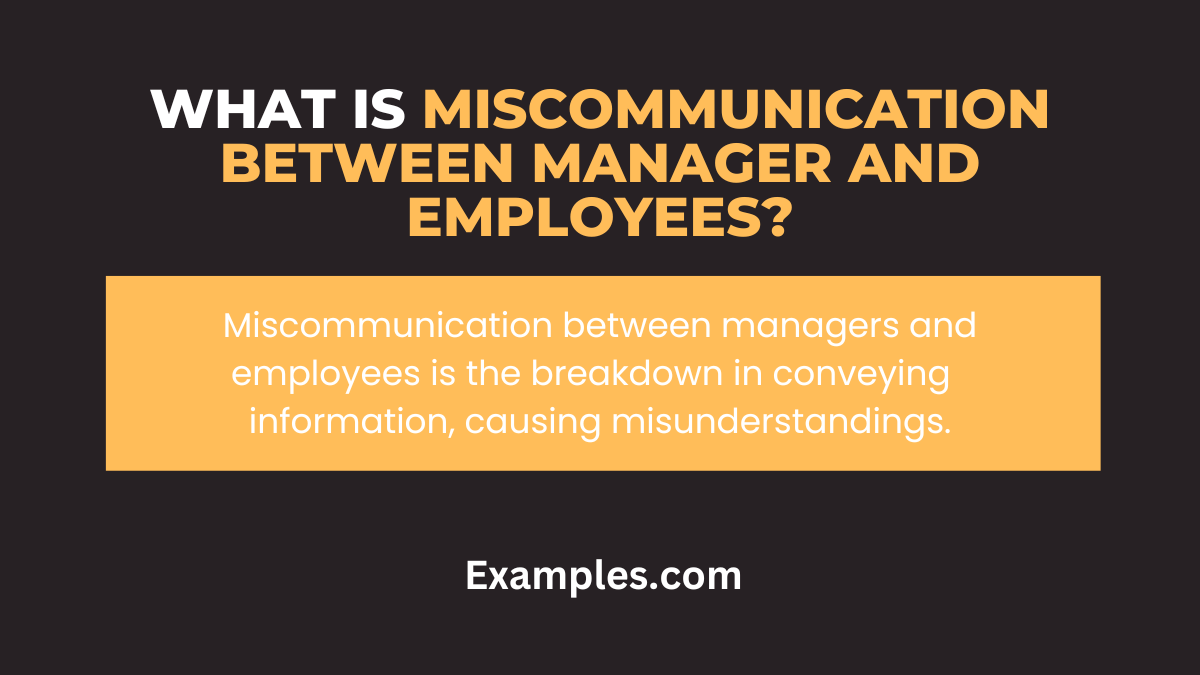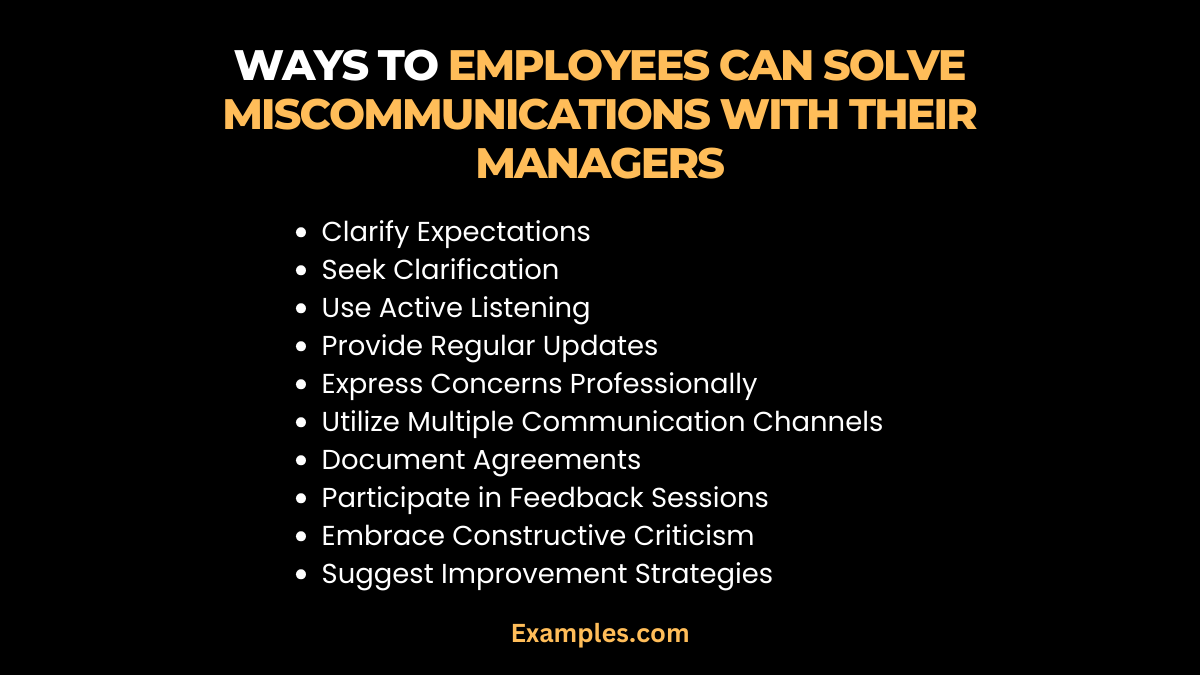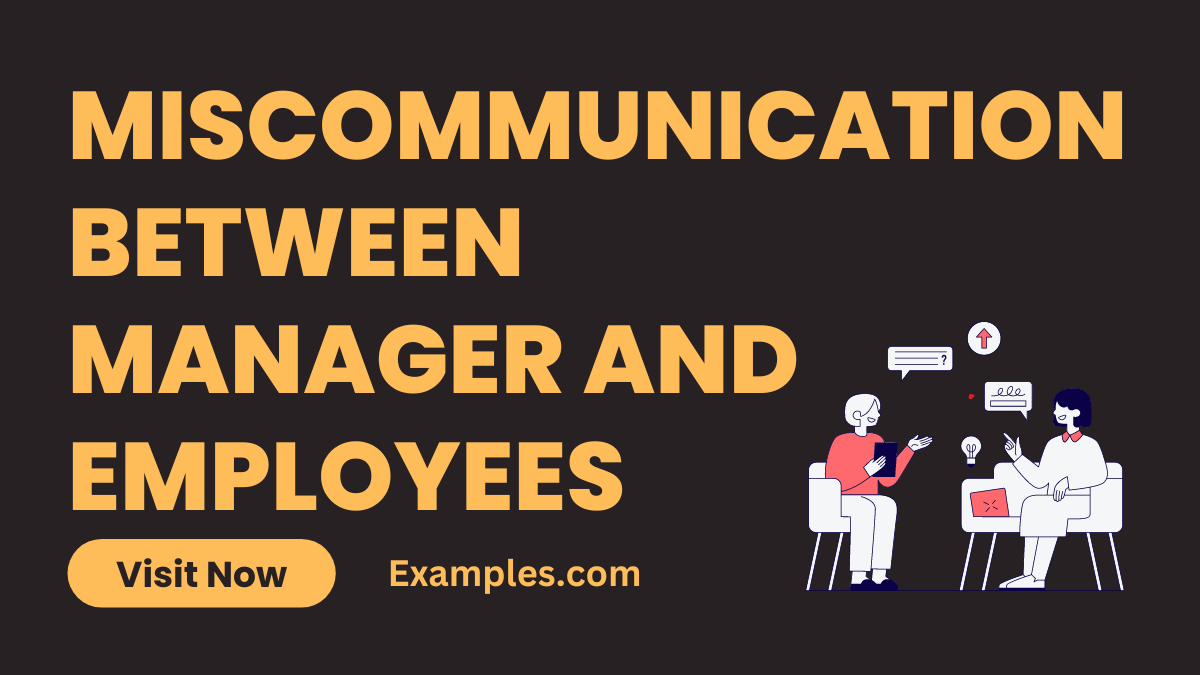9+ Miscommunication between Manager and Employees Examples
Embark on a transformative journey through the intricate landscape of workplace dynamics with our comprehensive guide on “Miscommunication between Manager and Employees.” Unlock the secrets to fostering effective communication, illustrated with real-life Communication Examples. Gain invaluable insights, strategies, and examples to bridge gaps, ensuring a harmonious work environment. Dive deep into the intricacies of professional interactions, empowering yourself to navigate challenges seamlessly. Elevate your communication skills and enhance workplace synergy with this indispensable guide.
What is Miscommunication between Manager and Employees?

Miscommunication between Manager and Employees refers to the breakdown or misunderstanding in the exchange of information between leadership and staff. In simple terms, it occurs when messages are unclear, misconstrued, or not effectively transmitted, leading to confusion, errors, and potential conflicts. This hampers the smooth flow of information crucial for a productive work environment. Understanding this concept is pivotal for fostering effective communication and cultivating a harmonious workplace.
Miscommunication between Manager and Employees in the Workplace:
Unlock the intricacies of workplace communication with our guide on miscommunication between managers and employees. Discover insightful strategies to mitigate misunderstandings and foster a collaborative work environment. Navigating these challenges is essential for enhancing overall productivity and job satisfaction.
- Assumption Avalanche:
- Example: In a team meeting, assuming everyone understood the project’s goal without explicit clarification.
- Email Echo:
- Example: A misinterpreted email leading to confusion and incomplete tasks.
- Selective Sharing Snag:
- Example: Withholding critical information unintentionally, affecting project progress.
- Hierarchy Hurdle:
- Example: A manager using complex language that employees find challenging to comprehend.
- Feedback Fog:
- Example: Vague feedback causing uncertainty about job performance and expectations.
- Deadline Dilemma:
- Example: Miscommunication on project deadlines leading to missed targets.
- Role Confusion Crisis:
- Example: Employees unsure of their responsibilities due to unclear role definitions.
- Meeting Mismatch:
- Example: Different expectations about meeting outcomes resulting in dissatisfaction.
- Policy Puzzle:
- Example: Employees misunderstanding company policies, impacting adherence.
- Technology Tango:
- Example: Relying solely on digital communication, missing non-verbal cues and nuances.
Ways to Employees Can Solve Miscommunications With Their Managers

Miscommunications between employees and managers can be effectively addressed with proactive and thoughtful approaches. Empower yourself with these strategies to bridge gaps and enhance workplace communication:
- Clarify Expectations:
- Initiate discussions with your manager to gain a clear understanding of expectations, ensuring alignment on tasks and goals.
- Seek Clarification:
- Don’t hesitate to seek clarification when instructions are unclear, avoiding assumptions and potential misunderstandings.
- Use Active Listening:
- Practice active listening during meetings and conversations, confirming your understanding and promoting clearer communication.
- Provide Regular Updates:
- Keep your manager informed about your progress, challenges, and achievements, fostering transparency and avoiding surprises.
- Express Concerns Professionally:
- Address concerns promptly and professionally, emphasizing a solution-oriented approach rather than dwelling on problems.
- Utilize Multiple Communication Channels:
- Tailor your communication style to match your manager’s preferences, whether through emails, meetings, or other channels.
- Document Agreements:
- Record important agreements and decisions in writing, creating a reference point to minimize misunderstandings.
- Participate in Feedback Sessions:
- Actively participate in feedback sessions, using constructive feedback as a tool for improvement and mutual understanding.
- Embrace Constructive Criticism:
- Welcome constructive criticism from your manager as an opportunity for growth, demonstrating a receptive attitude.
- Suggest Improvement Strategies:
- Propose strategies to improve communication within the team, emphasizing a collaborative approach to problem-solving.
What is a Good Way to Reduce Miscommunication between Employees and Managers?
Effective communication is the cornerstone of a thriving workplace. To minimize the risks and fallout of miscommunication between employees and managers, implement these strategic approaches:
- Transparent Leadership:
- Foster open communication channels, ensuring leaders transparently convey expectations, goals, and changes.
- Clear Communication Protocols:
- Establish standardized communication methods, minimizing ambiguity and ensuring everyone understands the preferred channels and formats.
- Regular Check-ins:
- Schedule frequent one-on-one meetings to discuss progress, address concerns, and provide a platform for clear communication.
- Active Listening Training:
- Conduct workshops on active listening skills, ensuring both managers and employees understand the importance of attentive engagement.
- Clarity in Instructions:
- Provide clear, concise, and detailed instructions to avoid misunderstandings in task assignments and project expectations.
- Encourage Questions:
- Foster a culture where employees feel comfortable seeking clarification, promoting a proactive approach to communication.
- Utilize Multiple Communication Channels:
- Diversify communication tools to accommodate various communication preferences, ensuring no one feels left out or overlooked.
- Document Important Conversations:
- Encourage the habit of documenting crucial discussions, decisions, and action items to minimize memory gaps and ensure accountability.
- Feedback Loops:
- Establish regular feedback loops, allowing both managers and employees to express concerns, suggestions, and observations.
- Training on Non-Verbal Cues:
- Provide training sessions on understanding non-verbal cues to enhance comprehension, especially in remote or diverse work environments.
In conclusion, mastering effective communication between managers and employees is paramount for a harmonious workplace. This comprehensive guide navigates the intricacies of miscommunication, providing real-world examples and practical solutions. Armed with insights, readers can proactively address challenges, fostering a culture of clear communication for a more collaborative and productive professional landscape.



